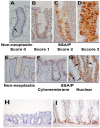Role of the β-Catenin/REG Iα Axis in the Proliferation of Sessile Serrated Adenoma/Polyps Associated with Fusobacterium nucleatum
- PMID: 33917384
- PMCID: PMC8067346
- DOI: 10.3390/pathogens10040434
Role of the β-Catenin/REG Iα Axis in the Proliferation of Sessile Serrated Adenoma/Polyps Associated with Fusobacterium nucleatum
Abstract
Although sessile serrated adenoma/polyps (SSA/Ps) may arise through a pathway different from the traditional adenoma-carcinoma sequence, details of SSA/P tumorigenesis still remain unclear. Fusobacterium nucleatum (Fn) is frequently detected in colorectal cancer (CRC) tissues and may play a pivotal role in colorectal carcinogenesis. Here, we investigated the relationship between Fn and the β-catenin/REG Iα axis in SSA/Ps and their involvement in the proliferation of these lesions. Fn was detected in SSA/Ps by fluorescence in situ hybridization using a Fn-targeted probe, and expression of β-catenin, REG Iα and Ki67 was examined using immunohistochemistry. Sixteen of 30 SSA/P lesions (53.3%) were positive for Fn. Eighteen SSA/P lesions (60%) showed β-catenin immunoreactivity in the tumor cell nuclei. A significant majority of Fn-positive lesions showed nuclear expression of β-catenin (87.5%) and higher REG Iα scores and Ki67 labeling indices relative to Fn-negative lesions. The SSA/P lesions expressing β-catenin in nuclei had significantly higher REG Iα scores and Ki67 labeling indices than those expressing β-catenin on cytomembranes. The REG Iα score was positively correlated with the Ki67 labeling index in SSA/P lesions. The treatment with Wnt agonist SKL2001 promoted nuclear β-catenin translocation and enhanced REG Ia expression in Caco2 cells. Fn may play a role in the proliferation of SSA/P lesions through promotion of β-catenin nuclear translocation and REG Iα expression.
Keywords: Fusobacterium nucleatum; Ki67; REG; polyp; proliferation; sessile serrated adenoma; β-catenin.
Conflict of interest statement
The authors declare no conflict of interest.
Figures




Similar articles
-
Overexpression of regenerating gene Iα appears to reflect aberration of crypt cell compartmentalization in sessile serrated adenoma/polyps of the colon.Diagn Pathol. 2013 Nov 13;8:187. doi: 10.1186/1746-1596-8-187. Diagn Pathol. 2013. PMID: 24225137 Free PMC article.
-
Molecular characterization of sessile serrated adenoma/polyps with dysplasia/carcinoma based on immunohistochemistry, next-generation sequencing, and microsatellite instability testing: a case series study.Diagn Pathol. 2018 Nov 20;13(1):88. doi: 10.1186/s13000-018-0771-3. Diagn Pathol. 2018. PMID: 30458818 Free PMC article.
-
Expression of β-catenin and REG Iα in relation to cell proliferative ability in salivary gland tumors.Exp Ther Med. 2010 May;1(3):437-443. doi: 10.3892/etm_00000068. Epub 2010 May 1. Exp Ther Med. 2010. PMID: 22993559 Free PMC article.
-
Endoscopic diagnosis of sessile serrated adenoma/polyp with and without dysplasia/carcinoma.World J Gastroenterol. 2018 Aug 7;24(29):3250-3259. doi: 10.3748/wjg.v24.i29.3250. World J Gastroenterol. 2018. PMID: 30090005 Free PMC article. Review.
-
Clinicopathological features, diagnosis, and treatment of sessile serrated adenoma/polyp with dysplasia/carcinoma.J Gastroenterol Hepatol. 2019 Oct;34(10):1685-1695. doi: 10.1111/jgh.14752. Epub 2019 Jun 30. J Gastroenterol Hepatol. 2019. PMID: 31158302 Review.
Cited by
-
Regulatory effects of oral microbe on intestinal microbiota and the illness.Front Cell Infect Microbiol. 2023 Feb 1;13:1093967. doi: 10.3389/fcimb.2023.1093967. eCollection 2023. Front Cell Infect Microbiol. 2023. PMID: 36816583 Free PMC article. Review.
-
A New Comorbidity in Periodontitis: Fusobacterium nucleatum and Colorectal Cancer.Medicina (Kaunas). 2022 Apr 15;58(4):546. doi: 10.3390/medicina58040546. Medicina (Kaunas). 2022. PMID: 35454384 Free PMC article. Review.
-
Moutai Distiller's grains Polyphenol extracts and rutin alleviate DSS-induced colitis in mice: Modulation of gut microbiota and intestinal barrier function (R2).Heliyon. 2023 Nov 11;9(11):e22186. doi: 10.1016/j.heliyon.2023.e22186. eCollection 2023 Nov. Heliyon. 2023. PMID: 38045189 Free PMC article.
References
-
- O’Brien M.J., Yang S., Mack C., Xu H., Huang C.S., Mulcahy E., Amorosino M., Farraye F.A. Comparison of microsatellite instability, CpG island methylation phenotype, BRAF and KRAS status in serrated polyps and traditional adenomas indicates separate pathways to distinct colorectal carcinoma end points. Am. J. Surg. Pathol. 2006;30:1491–1501. doi: 10.1097/01.pas.0000213313.36306.85. - DOI - PubMed
-
- Okamoto K., Kitamura S., Kimura T., Nakagawa T., Sogabe M., Miyamoto H., Muguruma N., Takayama T. Clinicopathological characteristics of serrated polyps as precursors to colorectal cancer: Current status and management. J. Gastroenterol. Hepatol. 2017;32:358–367. doi: 10.1111/jgh.13482. - DOI - PubMed
-
- Shida Y., Ichikawa K., Fujimori T., Fujimori Y., Tomita S., Fujii T., Sano Y., Oda Y., Goto H., Ohta A., et al. Differentiation between sessile serrated adenoma/polyp and non-sessile serrated adenoma/polyp in large hyper plastic polyp: A Japanese collaborative study. Mol. Clin. Oncol. 2013;1:53–58. doi: 10.3892/mco.2012.20. - DOI - PMC - PubMed
Grants and funding
LinkOut - more resources
Full Text Sources
Other Literature Sources
Research Materials
Miscellaneous

